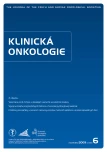Influenza Vaccination for Adult Patients with Solid Malignancies
Authors:
T. Büchler; J. Abrahámová
Authors place of work:
Onkologické oddělení Fakultní Thomayerovy nemocnice a 1. LF UK, Praha
Published in the journal:
Klin Onkol 2009; 22(6): 264-267
Category:
Přehledy
Summary
Seasonal influenza causes annual epidemics with significant morbidity in the general population and important mortality in high‑risk groups. Opinions on the suitability of patients with solid tumours in different phases of antineoplastic therapy to receive influenza vaccination vary considerably among oncologists, sometimes even within one center. Consequently, a large number of cancer patients fail to receive influenza vaccination. Recently, the situation has become even more complicated due to the emergence of the new pandemic A/ H1N1 („swine“ or „Mexican“) influenza. We review current knowledge on the epidemiology of influenza, vaccination recommendations, and the efficacy and toxicity of available influenza vaccines in the population of adult patients with solid malignancies.
Key words:
cancer – vaccination – human influenza – influenza – vaccines
Zdroje
1. Pandemie.mzcr.cz. Pandemický webový portál Ministerstva zdravotnictví ČR, Česká republika; c2009 [aktualizováno 29. října 2009; citováno 1. listopadu 2009]. Dostupné z: http:/ / pandemie.mzcr.cz.
2. Cooksley CD, Avritscher EB, Bekele BN et al. Epidemiology and outcomes of serious influenza‑related infections in the cancer population. Cancer 2005; 104(3): 618– 628.
3. Voordouw AC, Sturkenboom MC, Dieleman JP et al. Annual revaccination against influenza and mortality risk in community- dwelling elderly persons. JAMA 2004; 292(17): 2089– 2095.
4. Vakciny.net. Vakcíny a očkování – Internetové informační centrum, Česká republika; c1999– 2009 [aktualizováno 2. listopadu 2009; citováno 2. listopadu 2009]. Dostupné z: http:/ / www.vakciny.net.
5. Sukl.cz. Státní ústav pro kontrolu léčiv, Česká republika; c2007 [aktualizováno 30. října 2009; citováno 1. listopadu 2009]. Dostupné z: http:/ / www.sukl.cz.
6. Emea.europe.eu. European Medicines Agency, London, UK; c1995– 2009 [updated 2009 October 29; cited 2009 November 1]. Available from: http:/ / www.emea.europa.eu/ influenza/ vaccines.
7. Mzcr.cz. Ministerstvo zdravotnictví ČR, Česká republika; c2008 [aktualizováno 29. října 2009; citováno 1. listopadu 2009]. Dostupné z: http:/ / www.mzcr.cz (přístup 1.11.2009).
8. Stiver HG, Weinerman BH. Impaired serum antibody response to inactivated influenza A and B vaccine in cancer patients. Can Med Assoc J 1978; 119(7): 733– 738.
9. Ganz PA, Shanley JD, Cherry JD. Responses of patients with neoplastic diseases to influenza virus vaccine. Cancer 1978; 42(5): 2244– 2247.
10. Nordøy T, Aaberge IS, Husebekk A et al. Cancer patients undergoing chemotherapy show adequate serological response to vaccinations against influenza virus and Streptococcus pneumoniae. Med Oncol 2002; 19(2): 71– 78.
11. Brydak LB, Guzy J, Starzyk J et al. Humoral immune response after vaccination against influenza in patients with breast cancer. Support Care Cancer 2001; 9(1): 65– 68.
12. Anderson H, Petrie K, Berrisford C et al. Seroconversion after influenza vaccination in patients with lung cancer. Br J Cancer 1999; 80(1– 2): 219– 220.
13. Earle CC. Influenza vaccination in elderly patients with advanced colorectal cancer. J Clin Oncol 2003; 21(6): 1161– 1166.
14. Avritscher EB, Cooksley CD, Geraci JM et al. Cost‑effectiveness of influenza vaccination in working- age cancer patients. Cancer 2007; 109(11): 2357– 2364.
15. Cdc.gov. Center for Disease Control and Prevention, Atlanta, USA; c2000– 2009 [updated 2009 November 1; cited 2009 November 1]. Available from: http:/ / www.cdc.gov.
16. Sommer AL, Wachel BK, Smith JA. Evaluation of vaccine dosing in patients with solid tumors receiving myelosuppressive chemotherapy. J Oncol Pharm Pract 2006; 12(3): 143– 154.
17. Ortbals DW, Liebhaber H, Presant CA et al. Influenza immunization of adult patients with malignant diseases. Ann Intern Med 1977; 87: 552– 557.
18. Kunisaki KM, Janoff EN. Influenza in immunosuppressed populations: a review of infection frequency, morbidity, mortality, and vaccine responses. Lancet Infect Dis 2009; 9(8): 493– 504.
19. Kline RM. PET scan hypermetabolism induced by influenza vaccination in a patient with non‑Hodgkin lymphoma. Pediatr Blood Cancer 2006; 46(3): 389.
20. Focosi D, Caracciolo F, Galimberti S et al. False positive PET scanning caused by inactivated influenza virus vaccination during complete remission from anaplastic T- cell lymphoma. Ann Hematol 2008; 87(4): 343– 344.
21. Kersun LS, Coffin SE, Leckerman KH et al. Community acquired influenza requiring hospitalization: Vaccine status is unrelated to morbidity in children with cancer. Pediatr Blood Cancer 2009 Sep 9. [Epub ahead of print].
22. Barrière J, Otto J, Cua E et al. New influenza A (H1N1) pandemia and cancer patients: what do we do? Bull Cancer 2009 Oct 13. [Epub ahead of print].
Štítky
Detská onkológia Chirurgia všeobecná OnkológiaČlánok vyšiel v časopise
Klinická onkologie

2009 Číslo 6
- Metamizol jako analgetikum první volby: kdy, pro koho, jak a proč?
- Nejasný stín na plicích – kazuistika
- Fixní kombinace paracetamol/kodein nabízí synergické analgetické účinky
- Antidepresivní efekt kombinovaného analgetika tramadolu s paracetamolem
- Geriatrická křehkost a léčba bolesti
Najčítanejšie v tomto čísle
- Neo‑adjuvantná chemoterapia s následnou IDS (interval debulking surgery) v liečbe pokročilého karcinómu ovária – retrospektívna analýza
- Inhibítory aromatázy v prevencii rakoviny prsníka: možnosti aplikácie u premenopauzálnych žien
- Vakcinace proti chřipce u dospělých pacientů se solidními nádory
- Dispenzarizace osob s familiárním výskytem kolorektálního karcinomu
